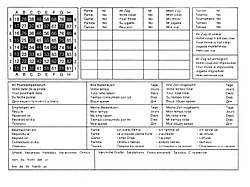Understanding and Using Algebraic Chess Notation

Chess is a game that has captured the hearts and minds of players for centuries. It's a battle of wits and strategy, where each move can make or break your chances of victory. In order to analyze and record these moves, chess notation was developed. One of the most widely used systems is algebraic notation, which provides a clear and concise way of documenting the game. In this blog, we will delve into the world of chess notation, specifically focusing on algebraic notation, and explore its importance in understanding and analyzing chess games.
What is Algebraic Notation?
Algebraic notation is a standardized method of recording chess moves using a combination of letters and numbers. Each square on the chessboard is identified by a unique coordinate, making it easy to pinpoint the location of a piece. The system uses a combination of uppercase letters to represent the pieces and lowercase letters and numbers to represent the squares.
Understanding the Basics
Before we dive deeper into algebraic notation, let's familiarize ourselves with the basic terminology used in chess:
The chessboard: The standard chessboard consists of 64 squares arranged in an 8x8 grid. The vertical columns are labeled with letters (a-h) from left to right, while the horizontal rows are numbered (1-8) from bottom to top.

Pieces: Each player begins the game with 16 pieces, including a king, queen, two rooks, two knights, two bishops, and eight pawns. The pieces are represented by the following letters in algebraic notation:
- King: K
- Queen: Q
- Rook: R
- Knight: N
- Bishop: B
- Pawn: no letter (only the square coordinates are used)
- Move notation: A move in algebraic notation consists of the piece abbreviation followed by the destination square. For example, if a pawn moves to e5, it would be recorded as "e5." If a knight moves to d4, it would be recorded as "Nd4."
Additional Notations
Captures: When a piece captures an opponent's piece, the move is denoted by "x" between the piece and the destination square. For example, if a bishop captures a pawn on e5, it would be recorded as "Bxe5."
Castling: Castling is a special move that involves the king and one of the rooks. Kingside castling (short castling) is denoted as "0-0," while queenside castling (long castling) is denoted as "0-0-0."
Check and Checkmate: When a move puts the opponent's king in check, the move is annotated with a "+". If the move results in checkmate, it is annotated with "#". For example, if a queen puts the opponent's king in checkmate on f7, it would be recorded as "Qf7#".
Advantages of Algebraic Notation
Algebraic notation offers several advantages that make it the preferred method of recording chess moves:
Universal and standardized: Algebraic notation is universally recognized and used across the chess community. It allows players from different countries and cultures to understand and analyze games without language barriers.
Concise and precise: The use of algebraic notation enables concise and precise recording of moves. It provides all the necessary information in a compact format, making it easier to read and analyze games.
Easy to learn and understand: Algebraic notation is relatively straightforward and can be learned quickly, even by beginners. With a little practice, anyone can become proficient in understanding and using it.
Analyzing Chess Games
Chess notation, especially algebraic notation, plays a crucial role in analyzing and studying chess games. By recording and studying games, players can gain insights into their own strategies, as well as learn from the strategies of other players. It helps in identifying patterns, tactical opportunities, and positional advantages.
Chess notation also allows players to recreate and replay games move-by-move, either on a physical board or through chess software. This ability to review and analyze games is invaluable for improving one's chess skills and understanding the intricacies of the game.

Here are a few examples of chess notations using algebraic notation:
Pawn Moves:
- e4: The white pawn moves from its starting position to the e4 square.
- d5: The black pawn moves from its starting position to the d5 square.
Piece Moves:
- Nf3: The white knight moves from its starting position to the f3 square.
- Bg5: The white bishop moves from its starting position to the g5 square.
Captures:
- Bxc6: The white bishop captures the black pawn on c6.
- exd5: The white pawn captures the black pawn on d5.
Castling:
- 0-0: White performs kingside castling.
- 0-0-0: Black performs queenside castling.
Check and Checkmate:
- Qh5+: The white queen moves to h5, putting the black king in check.
- Qh5#: The white queen moves to h5, delivering checkmate to the black king.
Promotion:
- e8=Q: A black pawn reaches the 8th rank and is promoted to a queen.
Move with Specific Disambiguation:
- Nbd2: There are two knights that could move to d2, but the knight from the b-file moves to d2.
These examples illustrate different types of moves and annotations using algebraic notation. It's important to note that the context of the game and the current position on the board is crucial in correctly interpreting these notations.
Algebraic notation is a powerful tool in the world of chess. Its standardized format provides a universal language for recording, understanding, and analyzing chess moves.
Whether you are a beginner or an experienced player, mastering algebraic notation is essential for improving your game and exploring the vast realm of chess strategy. So, embrace algebraic notation and embark on a journey to unravel the mysteries of the ancient game of chess!
Useful links




